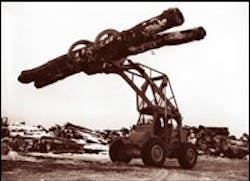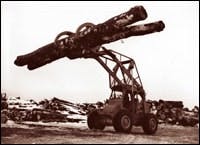A 50-Year Niche
Entrepreneur Phil LaTendresse ran a small manufacturing facility at L'Anse, Mich., called LaTendresse Manufacturing Co. He wanted a regular wheel loader to do more than merely load material. After several experimental machines, he invented the world's first forward-reaching, rough-terrain material handler in 1949, naming it the Cary-Lift. What sets the Cary-Lift apart from a regular wheel loader is its ability to extend its bucket arms forward and back when the machine is in a standing position. This is accomplished by attaching the pivoting loader arms to a movable frame that is actuated in turn by an extra pair of hydraulic rams.
When equipped with forks or pipe-handling grapple, this forward-reaching feature allows the operator to delicately pick and place a load or position the forks accurately under stacked material without having to depend on perfectly level ground. It also gives him superior forward reach capability beyond that of a similar-sized wheel loader. An additional bonus is full frontal visibility with overhead lifting arms pivoting at the rear.
In 1951, LaTendresse sold the Cary-Lift manufacturing rights to Pettibone Corp., and the first Pettibone Cary-Lift appeared soon afterward as the Model 54 with 10,000-pound lift capacity. In 1957, the company moved manufacture of the Cary-Lift from L'Anse to Baraga, Mich., where it is still manufactured by Pettibone Traverse Lift.
Over the years the Cary-Lift received many upgrades, and its design concept expanded into a wide range with lifting capacities from 4,000 to 70,000 pounds. The massive Super 70 Carry-Shovel of 1962 was powered by a Cummins 350-hp engine, carried a loader bucket of 26 cubic yards heaped capacity, and boasted a 6-foot forward hydraulic reach.
Pettibone Traverse Lift today operates as the Heavy Equipment Group of Pettibone LLC headquartered in Downers Grove, Ill. It is a direct descendent of the Pettibone company formed in 1881, which at that time was involved in manganese refining. Over the years, the company expanded into manufacturing and acquired a long list of companies. They operated at different locations but all under the umbrella of the main Pettibone corporation.
During the 1960s, the construction-equipment division (known as Pettibone Mulliken) operated eight integrated manufacturing plants. Products included wheel loaders, elevator loaders, bucket loaders, motor graders, mix-in-place concrete equipment, pumps, conveyors, rock crushers and screening and washing plants. Later, the company made a name for itself with rough-terrain mobile and hydraulic truck cranes.
Since its invention more than 50 years ago, the Cary-Lift has remained in continuous production and still forms the backbone of Pettibone's Heavy Equipment Division at Baraga, Mich.
You can read more about the evolution of construction equipment in Keith Haddock's illustrated book "The Earthmover Encyclopedia" available in most bookstores. Also, consider a membership in the Historical Construction Equipment Association, www.hcea.net .


